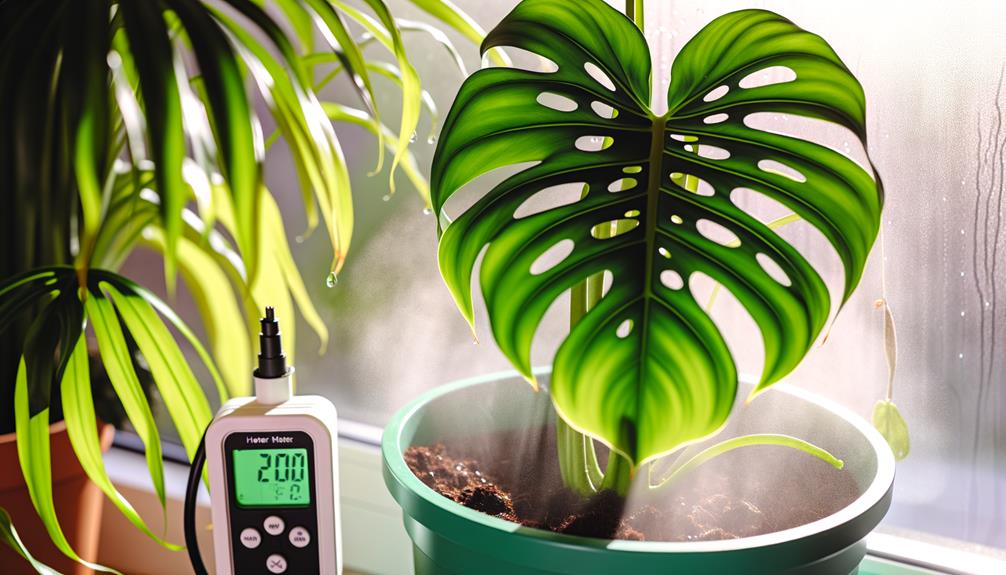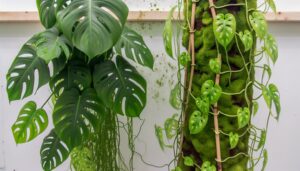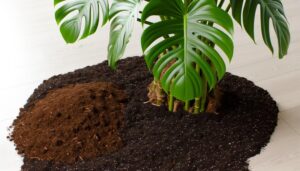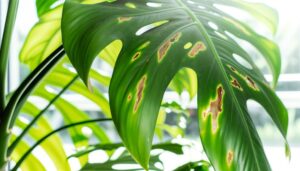Monstera Pinnatipartita Watering Needs
To keep your Monstera Pinnatipartita thriving, water when the top inch of soil feels parched. Use a well-draining mixture of peat moss, perlite, and orchid bark to prevent root rot.
Ensure pots have proper drainage apertures. Maintain humidity levels around 60-70%.
Use filtered, dechlorinated water with a pH between 5.5 and 7.0. Overwatering can lead to yellowing leaves, while underwatering may cause wilting.
Monitor soil moisture with a gauge for precision. Consistent moisture management guarantees healthy growth and vibrant foliage, making it essential for prime plant care.
Discover more nuanced tips for true monstera enthusiasts.

Key Takeaways
- Water Monstera Pinnatipartita when the top inch of soil is dry to the touch.
- Ensure pots have drainage holes to prevent water retention and root rot.
- Use a well-draining soil mix with components like peat moss, perlite, and orchid bark.
- Avoid over-watering to prevent yellowing leaves and root rot.
- Use filtered, dechlorinated water with a pH between 5.5 and 7.0.
Understanding Monstera Pinnatipartita
Monstera Pinnatipartita, a tropical climbing plant native to Central and South America, is renowned for its deeply lobed foliage and rapid growth.
You'll notice its leaves start as entire and gradually develop fenestrations, a key trait in the Araceae family. This plant uses aerial roots to cling to surfaces, enhancing its climbing ability.
Understanding its natural habitat is essential; it thrives under the canopy of rainforests, receiving dappled sunlight and high humidity. Proper watering replicates these conditions, ensuring the soil remains moist but not waterlogged.
Inadequate watering can hinder growth or cause root rot. Recognizing the plant's epiphytic nature helps you provide best care, promoting healthy development and vibrant foliage.
Ideal Soil Conditions
You'll want to prioritize a well-draining soil mix to prevent root rot in your Monstera Pinnatipartita. Incorporate organic matter like peat moss or compost to enhance nutrient availability and aeration.
Regularly monitor soil moisture levels, ensuring it stays evenly moist but never waterlogged.
Well-Draining Soil Mix
An ideal soil mix for Monstera pinnatipartita should comprise well-draining components such as peat moss, perlite, and orchid bark to prevent waterlogging and promote root health. You need a soil mixture that balances moisture retention and aeration.
Here's a recommended mix:
- Peat moss: Retains moisture while providing slight acidity.
- Perlite: Enhances soil aeration and drainage.
- Orchid bark: Improves drainage and mimics natural growing conditions.
- Activated charcoal: Prevents root rot and absorbs impurities.
Combining these components ensures that your Monstera pinnatipartita's roots stay healthy by avoiding waterlogged conditions, which can lead to root rot. This mix will provide the necessary environment for optimal growth and vitality.
Organic Matter Content
Incorporating natural material into your soil mix enhances nutrient availability and supports beneficial microbial activity essential for Monstera pinnatipartita's growth. Aim to include compost, aged manure, or peat moss, as these materials improve soil structure and increase its water-holding capacity.
Organic matter decomposes, releasing nutrients like nitrogen, phosphorus, and potassium, which are critical for healthy foliage development. Additionally, it fosters a thriving soil ecosystem by promoting the proliferation of microorganisms that aid nutrient cycling and root health. Make sure your organic components are well-decomposed to avoid phytotoxicity.
Regularly replenishing organic matter maintains prime soil fertility, ensuring your Monstera pinnatipartita receives the essential nutrients it needs for robust growth. Balancing these elements creates an ideal growing environment.
Soil Moisture Levels
Maintaining the right soil moisture levels is critical for Monstera pinnatipartita's health and growth. You need to make sure that the soil is consistently moist but not waterlogged.
To achieve this balance, consider the following guidelines:
- Soil Composition: Use a well-draining mix, such as a blend of peat moss, perlite, and orchid bark, to prevent water retention.
- Watering Frequency: Water once the top inch of soil feels dry to the touch. Over-watering can lead to root rot.
- Humidity: Maintain humidity levels around 60-70%, as dry air can impact soil moisture.
- Pot Selection: Choose pots with drainage holes to allow excess water to escape and prevent stagnation.
Choosing the Right Pot
Choosing the correct pot for your Monstera Pinnatipartita is crucial for promoting ideal drainage and root health. Select a pot with multiple drainage holes to avoid water accumulation at the base, which can result in root rot.
Terracotta pots are highly recommended because of their porous quality, allowing excess moisture to evaporate and improving aeration. Make sure the pot size is suitable—too large, and the soil may retain excessive moisture; too small, and the roots may become restricted. A pot that's 1-2 inches larger in diameter than the root ball is perfect. This guarantees sufficient space for growth without compromising moisture levels.
Regularly inspect for root-bound conditions and repot as needed to maintain peak root health.
Watering Frequency
Understanding the specific watering needs for your Monstera Pinnatipartita is essential for promoting its best growth and health. Aim to maintain a consistent watering schedule that mimics its natural tropical habitat. Here's a precise guide to follow:
- Assess Soil Moisture: Check the top 2-3 inches of soil; water only when it's dry. This prevents overwatering.
- Water Quantity: Provide thorough watering until water drains from the pot's bottom. This promotes deep root hydration.
- Frequency: Typically, water every 1-2 weeks, adjusting for seasonal changes and indoor humidity levels.
- Environmental Factors: Consider temperature and light exposure. Higher temperatures and increased light require more frequent watering.
Adhering to these guidelines promotes your Monstera Pinnatipartita thrives in its environment.
Signs of Under-Watering
One clear sign of under-watering in your Monstera Pinnatipartita is the yellowing and wilting of its lower leaves. This happens because the plant is unable to transport sufficient water to its extremities, causing cellular dehydration and chlorophyll breakdown.
You may also notice the soil pulling away from the edges of the pot, indicating severe dryness. The leaves might feel crisp to the touch and lack their usual turgor pressure, which results in a droopy appearance. Additionally, stunted growth is often observed as the plant prioritizes survival over new development.
Make sure you check the moisture level in the soil regularly and adjust your watering schedule to maintain consistent hydration, preventing these stress symptoms in your Monstera Pinnatipartita.
Signs of Over-Watering
While under-watering presents its own set of challenges, over-watering your Monstera Pinnatipartita can be equally harmful, often leading to root rot and fungal infections. Recognizing the signs of over-watering is essential.
Key indicators include:
- Yellowing Leaves: When the leaves turn yellow, it's often a sign of waterlogged roots.
- Wilting: Although it may seem counterintuitive, over-watered plants can wilt due to oxygen deprivation in the root zone.
- Mushy Stems: Stems become soft and mushy, indicating advanced root rot.
- Fungal Growth: Mold or mildew on the soil surface is a clear sign of excessive moisture.
Pay close attention to these symptoms to guarantee your Monstera Pinnatipartita remains healthy and thriving.
Seasonal Watering Adjustments
Adjusting your Monstera Pinnatipartita's watering schedule based on the season is crucial for its best growth and health. During the growing season, typically spring and summer, you should increase watering frequency to accommodate the plant's heightened metabolic rate and transpiration.
Make sure the soil remains consistently moist but not waterlogged. In contrast, during the dormant periods of fall and winter, the plant's metabolic activities slow down, requiring reduced watering. Allow the top inch of soil to dry out between waterings to prevent root rot.
Monitoring environmental factors such as humidity and temperature will also guide your adjustments. By tailoring your watering schedule seasonally, you'll support optimal physiological processes and maintain the overall well-being of your Monstera Pinnatipartita.
Water Quality Considerations
Maintaining the water you use is free from impurities and at the correct pH level is crucial for the health of your Monstera Pinnatipartita. Tap water often contains chlorine and fluoride, which can harm your plant.
To optimize water quality, consider these steps:
- Use Filtered Water: This eliminates harmful chemicals and heavy metals.
- Check pH Level: Aim for a pH between 5.5 and 7.0, as Monstera Pinnatipartita thrives in slightly acidic to neutral water.
- Dechlorinate Water: Let tap water sit for 24 hours or use a dechlorinating agent to remove chlorine.
- Avoid Softened Water: It contains sodium, which can be harmful to plant health.
Following these guidelines guarantees your plant absorbs essential nutrients effectively.
Proper Drainage Techniques
Proper drainage techniques are essential to prevent root rot and guarantee your Monstera Pinnatipartita remains healthy. First, select a pot with drainage holes to allow excess water to escape.
Use a well-draining soil mix, such as one containing peat, perlite, and orchid bark, to promote aeration. Make sure the bottom layer of the pot has coarse material like gravel or clay pebbles to improve drainage.
Water your plant thoroughly but let the soil dry out between waterings. Consistent moisture without waterlogging is crucial. Regularly check the pot's drainage efficiency and avoid leaving the pot in standing water.
These steps ensure prime root health by preventing anaerobic conditions that lead to root rot, thereby promoting vigorous growth.
Humidity and Its Impact
Maintaining ideal humidity levels is essential for Monstera Pinnatipartita's health. You'll need to aim for humidity levels between 60% and 80% to mimic its natural tropical environment.
Use a hygrometer to monitor conditions, and consider using a humidifier or pebble tray to maintain consistent humidity.
Ideal Humidity Levels
Humidity plays a crucial role in the health of Monstera Pinnatipartita, greatly impacting its growth and overall well-being. This tropical plant thrives in high humidity conditions, typically around 60-80%. When humidity levels drop, you may notice slower growth, browning leaf edges, and reduced leaf size.
To optimize conditions, monitor your indoor environment and aim for:
- Consistent humidity: Maintain levels above 60% for robust growth.
- Preventing dryness: Avoid air from becoming too dry, especially in winter.
- Humidity sources: Use humidifiers or place water-filled trays nearby.
- Leaf inspection: Regularly check for signs of low humidity stress.
Understanding these factors helps you create a conducive environment for your Monstera Pinnatipartita to thrive.
Humidity Maintenance Tips
To keep your Monstera Pinnatipartita thriving, maintain high moisture levels by using tools like humidifiers and regularly misting the plant. Moisture impacts the plant's physiological processes, including transpiration and nutrient absorption.
When moisture levels drop, the plant's stomata close to conserve water, which can hinder photosynthesis and growth. Aim for a relative moisture level of 60-80%. You can also place a tray with water and pebbles under the pot to increase local moisture. Avoid placing the plant near heaters or air conditioners, as they can reduce moisture.
Regularly check the moisture with a hygrometer to ensure best conditions. By maintaining appropriate moisture, you promote healthy leaf development and overall plant vigor.
Monitoring Moisture Levels
Consistently checking the soil's moisture levels is essential for ensuring your Monstera Pinnatipartita thrives. Use a systematic approach to monitor moisture accurately. Here's how:
- Soil Moisture Meter: Invest in a soil moisture gauge. Insert it into the soil to get an accurate reading. Aim for a moisture level of 5-7.
- Finger Test: Insert your finger about 2 inches into the soil. If it feels dry at this depth, it's time to water.
- Visual Inspection: Observe soil color and texture. Dry soil appears lighter and more crumbly.
- Weight Test: Lift the pot. A heavy pot indicates wet soil, while a lighter pot suggests dryness.
Regular monitoring prevents overwatering and under-watering, maintaining ideal plant health.
Troubleshooting Common Issues
Identifying and addressing common issues promptly guarantees your Monstera Pinnatipartita remains healthy and vibrant. If you notice yellowing leaves, it's often a sign of overwatering. Assess soil moisture and reduce watering frequency.
Brown leaf tips typically indicate low humidity. Employ a humidifier or mist leaves regularly.
Root rot manifests as mushy, dark roots and necessitates immediate repotting with well-draining soil.
If leaf drop occurs, check for consistent watering routines; erratic watering can stress the plant.
Wilting might suggest underwatering or poor soil aeration. Ensure soil remains moist, not saturated, and consider soil amendments to improve drainage.
Conclusion
You've now got the lowdown on keeping your Monstera pinnatipartita happy and hydrated. Picture your plant thriving, its lush leaves unfurling like green flags of victory.
Stick to the right soil, pot, and watering routine, ensuring proper drainage and humidity. Keep an eye on moisture levels to avoid the droop of under-watering.
With these tips, your Monstera will flourish, transforming your space into a vibrant jungle oasis.






